
The road to recall

Why recall elections cause more harm than they’re worth +opINIoN, page 5


The road to recall

Why recall elections cause more harm than they’re worth +opINIoN, page 5
The Badgers gear up to play the Gophers for paul Bunyan’s axe +SpoRTS, page 8
By Cheyenne Langkamp
The Daily CarDinal
The UW-Madison Faculty Senate passed a resolution officially addressing recent budget cuts to the UW System Monday.
The legislation asks the governor and the Wisconsin State Legislature to reduce the UW System’s portion of budget cuts to a more proportional level and “renew the state’s investment in education.”
In October, state legislators announced $65.7 million in cuts to the UW System in addition to the $250 million in original cuts. The new cuts will account for 38 percent of total cuts included in the state’s lapse.
Brad Barham, chair of the Faculty Senate’s University Committee, brought the resolution before the senate. Barham said the resolution is meant to address the “repeated and disproportionate” cuts to education in recent years.
“We ask the Faculty Senate to make a stand here,” said Braham.
“This is a phenomenal state, but it’s a phenomenal state going down fast if this continues.”
Interim Chancellor David Ward said letters advocating for a response
have been sent from a variety of sources within the system.
“There has been some disquiet about whether this proportion really was fair,” Ward said. “It really was not fair from our point of view. It seems clear that we need to make a stance on this.”
The Faculty Senate discussed the resolution and potential chang-
“This is a phenomenal state, but it’s a phenomenal state going down fast if this continues”
es that could improve it.
Faculty Senator Mark Etzel suggested the legislation include information showing the public how cuts to the UW System will directly affect them.
“I wonder if there’s [a list] of things you could say that will impact someone sitting at home that’s a tax payer and say why [they] should care,” Etzel said.
By Corinne Burgermeister
The Daily CarDinal
Many attendees at a Memorial Union open forum Monday were happy to see compromise and clarity as members of the Memorial Union Design Committee introduced updated renovation plans.
Alan Fish, associate vice chancellor for facilities, planning and management, introduced an alternative proposal for the union theater addition after a slight majority of students recently voted against the original proposal in an Associated Students of Madison referendum.
“After the referendum, I think it was clear that we needed to redesign the theater lounge,” Colin Plunkett, student manager for Memorial Union Reinvestment Project, said. “It’s important for students to know that we value them and we heard what they have to say.”
Compared to the former design’s
curved front that extended onto the terrace, the new proposed addition would be rectangular and closer to the building. Fish said the new design respects the original historic building, which is a priority among students, community members and the design committee.
While the new model is not final, Fish said it is headed in the right direction.
”[It is] a new direction that we think will make it a better design architecturally and still functional for what we want to do,” Fish said.
UW-Madison graduate Dylan Mathieu said he has been attending MUR meetings for the past couple years and had been growing increasingly angry about the proposed union theater renovations, until today.
“At first I felt like the students were being ignored for the needs of the theater department primar-
renovations page 3


Faculty Senator Sarah Goldrick-Rab said it’s important for the public to know that these cuts are a result of state, not university, actions.
“It needs to be made abundantly clear that the faculty are saying it is not educators seeking to charge
these students more money, but it’s the state that’s doing it’s job,” Goldrick-Rab said.
The senate passed the resolution with the intention of creating a second and more specific resolution to address the issue in their December meeting.
By Jack Casey The Daily CarDinal
Wisconsinites seeking concealed carry permits will not have to complete a four-hour-long training requirement after a legislative committee ruling Monday.
The Joint Committee for Review of Administrative Rules suspended Department of Justice rules that would have required those seeking concealed carry permits to complete the training.
They also suspended the requirement that program instructors need eight hours of training before being able to teach a course on gun safety.
The suspensions apply to the new state law that went into effect Nov. 1 allowing citizens above the age of 21 to obtain a permit to carry concealed weapons.
The National Rifle Association previously said in a letter they were concerned the DOJ was placing too many restrictions on the law, including the four hour training requirement.
But Attorney General J.B. Van

ignasiak ignastrodamous

Are there any genuine men out there? I’ve had female friends complain that all men are manipulative creatures who always have some type of hidden agenda, and I have found myself constantly coming to the defense of the male species. No longer will I do this. For now, I agree. Never trust a man with a smile and never give his small talk the time of day.
Every time a man has approached me at the gym, I’ve always wanted to believe that he was just friendly and outgoing like myself or really was interested in my opinion. However, as I’m sure many females can attest, if a guy starts talking to you at the SERF, it’s probably not because he wants advice on how to strengthen his external rotators so his disproportionate kyphotic posture—due to excessive bench pressing—doesn’t lead to further shoulder impingement.
“But what could he possibly want from me?” I asked myself as my most recent gym conver-
sation drifted from working out to when I have free time. Past experience has taught me that for some reason I give off gay vibes, but I’ve since learned to take measures to clear up any confusion about my sexuality by judiciously referencing females in my life that may or may not actually exist. “Yeah, these squats are going to make my glutes sooo sore. It’s a good thing I have a small posse of ladies to massage my muscles and spoon feed me protein shakes.”
Now I know men can also be clueless, but I thought this proclamation of unabashed heterosexuality would be enough to deflect any man’s romantic advances. Yet, they continued coming. This time it was in the form of unearned flattery: He told me, “You seem like a personable, ambitious, confident, outgoing, determined individual.”
My first thought upon hearing this was what any person would think after hearing a complete stranger describe him with a bunch of vague qualities everyone likes to think they possess: “What an insincere flatterer,” I thought. “I’ll bet he says that to everyone. He doesn’t even know me.”
However, my second thought was, “Well everything he said has
been true. Maybe I give off those vibes as well.”
I accepted his compliments, perhaps naively, as being genuine and continued the conversation. I worried that in doing so I would send the wrong signals, but much to my relief his motivations started to reveal themselves as he proceeded to ask me a slew of innocuous-sounding questions psychologists call a yes-set.
For now, I agree. Never trust a man with a smile and never give his small talk the time of day.
He started with something anyone would say yes to: “Do you wish you had more time?” YES. Next: “Do you wish you had more money?” YES. Thankfully, after two questions, I became privy to his seedy games because if I hadn’t, pretty soon I’d be saying yes to, “Would you like to spend your Friday nights going
door to door trying to sell diabetic grandmothers sugar-free candy as pawn in our multi-level marketing scheme?”
I then called him out: “So all of this has just been over some stupid business venture?” He vehemently denied it, told me I was unique and proceeded to draw his business model, which, when finished, was a three-sided figure with a wide base and point on top. Geometry has never been my strong suit, but this was either a pyramid or a really bad Christmas tree. Since the triangle didn’t have a funny doll with a halo on top, I was inclined to believe it was a pyramid. Next time an overly friendly man approaches you at the gym, save yourself the time and anxiety and just say, “I don’t want anything to do with your pyramid scheme, Mr. Ponzi. I hope your company relocates to Egypt and you get marred in a protest.” Maybe he just wants a spot, but it’s not worth the risk. Plus, then you can avoid completely humiliating yourself by thinking his advances are because of your good looks.
Tired of getting hit on or conned into a business venture while workin’ on your fitness? Share your frustrations with Elliot by e-mailing him at ignasiak@wisc.edu.
JaCQUElinE sCHaEFER guest columnist
It’s a beautiful morning as you traipse into the nearest coffee shop for your essential caffeine buzz. Your mind is a little foggy because it’s void of stimulating drugs. Everything is much too peaceful for what’s about to happen: the order, and worse yet, the pick-up. No one is sure when or how it happened, but a coffee order has become a natural social judgment.
The order: I step up to the open barista; I don’t let her apron fool me; I fully acknowledge her as a judgmental coffee elitist in proletariat disguise. I force myself to ignore the fact that she thinks my complex order is completely crackedout. She takes it without even glancing up, thank God.
The pick-up: I am now in a congregated crowd surrounding the circular out-put table where one glorified drink is placed every few seconds. This is the worst part of my day. The barista loudly shouts the exact order—with each exact detail. If you think that coffee orders

don’t reveal anything about you, think again. My palms grow sweaty, and my foot tapping increases. Maybe I don’t even need caffeine anymore. The barista barks out several drinks, and I can tell who is going for that beverage before it even lands on the serving table.
“VENTI CARAMEL
MOCHA FRAPPUCCINO!”
Woah. That girl must be having a rough day. A pink-faced girl slugs up to the pick-up counter and the wide cup is grasped by her little fingers.
off with her pony tail bouncing behind her.
“DOUBLE SHOT OF ESPRESSO!” European. A slender man dressed in a black turtleneck, sunglasses (even though it’s cloudy out) and leather shoes takes his double shot without noticing any of us. I wish I could be like him.

“GRANDE HALF-CAF
SKINNY LATTE!” What a lightweight. Life must be rough for someone who is scared of both caffeine and fat. A small girl wearing black running shorts and athletic shoes steps through the crowd and takes
“VENTI COFFEE WITH STEAMED SKIM!”
Highmaintenance college student. A girl with the new Marc Jacobs tote bag, which is jammed with textbooks, reaches in for her gallon-sized coffee. Enjoy that steamed foam, princess.
“TALL HOUSE COFFEE, REFILL!” Poor and plain. Maybe house coffee is confused with “classic,” but I think the rest of the crowd was thinking
plain and passive. A bearded 20-something draped in flannel modestly takes his used travel mug; wow his eyes are beautiful... but all he got was a refill.
“TALL SKINNY VANILLA LATTE!” OK. Get a mind of your own. I look for the Ugg boots and the North Face. There she is, fumbling in her Longchamp bag as she accepts her drink.
“TALL AMERICANO WITH A SHOT OF VANILLA AND SOYMILK!” All eyes are on me and my unthoughtful lurch forward. Damn, I should have slowly, nonchalantly slunk up to the table so people would have forgotten my ridiculous order by then. Could the way I approach my order change the judgments being made about me? Most likely no. The only way to move beyond coffee judgments is acceptance. I accept that I am a control freak down to my coffee order, and maybe this public display is actually freeing me from the closet I’m hiding in.
E-mail your coffee order or pass on your own secret judgments to jcschaefer@wisc.edu.
you’re a smooth talker?
it.
Beginning in fall 2012, UW-Madison’s Sellery Hall will house a residential learning community for students interested in a variety of creative arts disciplines.
Residential learning communities, housed in residential halls, seek to engage students, faculty and staff around a specific area of focus.
The new residential learning community, called the Creative Arts and Design Community, will welcome students interested in art,
dance, engineering, design, film, fashion, music, computer science and theater.
Sellery Hall will undergo renovations to its facilities to create a space for CAD students. The renovations will also provide students with access to music practice rooms, small work studios, a computer lab and other equipment.
The CAD community will host specialized programs including seminars, speakers, performanc-
es, trips and outreach opportunities intended to enhance students’ creative skills.
University Housing began planning for the CAD community last year after it received funds from the Madison Initiative for Undergraduates to expand the university’s learning communities.
This will be the university’s eighth residential learning community, including three already located in Sellery Hall.
By Mckenna Kohlenberg
The Daily CarDiNal
State Sen. Frank Lasee, R-De Pere, asked the state Monday to return $49 million in federal grant money designated to implement the Patient Protection and Affordable Care Act in Wisconsin.
The Affordable Care Act that passed in March 2010 aims to increase health care coverage by requiring individuals to get either private or public health insurance.
Wisconsin was one of seven states to receive “Early Innovator” funds in February from the U.S. Department of Health and Human Services.
The state would use the funds to develop technological programs that would make choosing health insurance easier for consumers by 2014.
Lasee said people should be concerned by the Walker administration’s “mixed messages” in keeping the federal funds.
“It can’t be an accident that on
one hand the State of Wisconsin is saying we reject ObamaCare, while on the other, we have pushed toward it,” Lasee said in a statement. “Until the governor’s administration returns $49 million in Early Innovator funds, Wisconsin remains at risk.”
Lasee, the chair of the Senate Committee on Insurance and Housing, also said Nov. 1 he would prevent the passage of Assembly Bill 210 that would have aligned state law with the Affordable Care Act.
By Meghan Chua
The Daily CarDiNal
Members of the North Pinckney Street Plaza Selection Committee discussed the various proposals for the location’s public sculpture Monday, requesting modifications from one artist’s proposal.
Aaron Stephan’s design, “Luminous Flux,” is composed of streetlight-inspired, intertwined poles that would stand on the North Pinckney Street Plaza.
Ultimately, the committee hopes to submit one proposal to the National Endowment for the Arts to receive consideration for a grant. Some committee members believe, of the four proposed sculptures under consideration, Stephan’s would be the most competitive for the grant.
However, there is currently no guarantee of the NEA funds, which would amount to around $30,000.
The committee had previously asked another artist, David Boyer, to modify his “Sustainabilitree” design for the committee’s consideration

The changes, including a revised base and a rusted finish, were presented at Monday’s meeting, but did not impress the committee members to the extend they had hoped.
Downtown resident Thomas Basting said Boyer’s sculpture was “not unique.”
“I just have a problem with it from an artistic standpoint,” Basting said.
According to Ald. Mike Verveer, District 4, the committee will review Stephan’s modified designs at their next meeting in about a week.
A Madison man alerted authorities to his neighbor’s overdose Sunday morning, shortly after being released into his neighbor’s care following his own overdose treatment.
The man who first experienced a heroin overdose was delivered to the hospital the previous evening after being discovered lying unconscious. After he was given treatment, the man was released
training from page 1
Hollen said at the JCRAR meeting the DOJ found four hours is the minimum amount of time for a comprehensive firearms safety training course.
The standards adopted in the DOJ’s emergency rule fulfill the legislatures’ intent to have a training requirement in the law, while creating among the “most flexible and liberal training requirements in the nation,” Van Hollen said.
from the hospital to his neighbor, the designated “responsible party,” according to Madison Police Public Information Officer Joel DeSpain.
“Hospital staff said a little more than an hour after the release, a second overdose patient came rolling in around 5:30 a.m,” said DeSpain in the incident report. “They recognized him, because he had just been there. He was the “responsible
Assembly Majority Leader Scott Suder, R-Abbotsford, said that by suspending the requirements, the JCRAR “followed the lead of 33 other states that do not specify a required number of hours for training.”
“Instead [they] decided to trust the judgment of our law abiding citizens to choose the training course that best fits their needs,” Suder said in a statement.
Suder said those seeking permits still need to pass a background

By David Klein The Daily CarDiNal
The Student Service Finance Committee decided Monday to delay the ruling on the Multicultural Student Coalition’s appeal for funding eligibility until next week.
After SSFC ruled MCSC did not spend more than 50 percent of its time directly serving students and was thus ineligible for funding, MCSC appealed the ruling last Thursday.
MCSC members said SSFC did not have a standardized process for determining what constitutes a “direct service.”
Other student groups from across the UW-Madison campus backed MCSC, saying their student groups had faced similar problems in past years.
MCSC Diversity Educator Rebecca Pons said a third party could best decide whether the group is eligible for funding.
“This appeals process was created but never implemented in a
renovations from page 1
ily,” Mathieu said. “But to see this tonight, this is wonderful. It’s a compromise that I think is going to work for everyone.”
party” who had earlier picked up the first overdose patient.”
Following his release, the man sleeping in his neighbor’s apartment when he awoke to find him unconscious after his neighbor had allegedly ingested heroin, the police report said.
“The first patient, still wearing his hospital bracelet, attempted CPR, and then called 911,” DeSpain said.
check and receive training.
“For those that say today’s actions somehow gutted the training requirements for obtaining permits, nothing could be further from the truth,” Suder said.
But State Rep. Donna Seidel, D-Wausau, said the ruling is evidence Republicans are out of touch with people’s concerns.
“Suspending these requirements is an abuse of power that will endanger the lives of Wisconsinites across our state,” Seidel said.
Attendees also said they were concerned the “Alumni Park” set to replace the Union’s parking lot will limit parking availability, especially for guests with specialized handicap vehicles that may not fit in ordinary parking spots.
trained fashion,” Pons said. “The answer to this issue is probably at the law school or beyond.”
SSFC Rep. Justin Bloesch said he plans to consult with a UW professor to determine if MCSC spends more than 50 percent of its time directly serving students. Bloesch said he hopes to use statistical analysis to interpret MCSC’s service hours.
“We’ve consulted the qualitative info,” Bloesch said after the meeting. “Now we’re trying to quantify it.”
The ruling was tabled for next Monday’s meeting.
The SSFC also amended legislation that would put an additional check on the committee.
The amendment would give the Rules Committee, a standing body of ASM, the charge to review all new forms and applications that any ASM body would make.
The Associated Students of Madison Student Council will hear the proposed amendment at their meeting Wednesday.
Fish said the group is working to create disabled spots along or adjacent to Langdon Street to accommodate these vehicles.
Design plans as well as samplings of carpets, tiles, color schemes and other interior decoration materials will be displayed in the Memorial Union’s Browsing Library Tuesday from 11 a.m. to 6 p.m. Visitors can vote for their favorites and leave comments on the sample boards.


I’ve had this notion in my head for a few months that maybe people are more important than music. It’s an obvious idea, but when discussing music I think there’s this admittedly natural tendency lionize form, texture and notes on a page. This tendency most often manifests in serious musicians.
Conversely, there’s this partially unacknowledged countertradition among rock and pop critics. Most critics gained their credentials by passively engaging with a large amount of music over time. A few may have, at some point, attempted to become musicians and had their dreams frustrated and strangled out. More, I suspect, lacked the courage or initiative to ever pick up a guitar in the first place. They are the scrubs, the nerdiest of the nerds vainly struggling to understand and control a world to which they do not belong.
Critics tend to use a semipopulist language meant to appeal primarily to non-musicians. They discuss the sociological, literary or political impli-
cations of artists’ work, often disguising their limited engagement with musical elements in flowery language and simile.
Understandably, a lot of muses, metal heads and classical violinists find this method of art critique infuriating. It rewards the acquisition of a liberal arts degree and devalues knowledge of musical theory. Surely, this cannot be the modern state of pop music criticism?
Critics tend to use a semipopulist language meant to appeal primarily to non-musicians.
Though I can hardly be called a serious rock critic, I definitely choose to align myself with the tradition of anti-musical music appreciation. A slave to the endless online catalog of rock reviews since the eighth grade, I unknowingly internalized an aversion to compositional intelligence early in my career as a music fan.
It wasn’t until my surprisingly powerful identification with the Replacements’ “I Hate Music” that I really became
aware of the terrible implications of my rock ‘n’ roll indoctrination. You see, I got off on that line Paul Westerberg croaked out about how, “it has too many notes!”
Always a lyrics geek, I was big on cult-crazy mythologies of Dylan and the Beatles from the start. For a variety of reasons, I quickly became attracted to punk rock and noise. Although some of these reasons were musical, a whole lot were social too. So while I dug the Mekons’ lilting country-folk and roll swagger, I ultimately spent a lot more energy and time engaging with their curiously traditionalistic ideology of anarchy.
Certain highly trained musicians may find the simple, formulaic chord changes and 4/4 rhythms that pervade the Mekons’ Fear and Whiskey highly offensive. A classically disciplined musician has the ability to truly appreciate the complex patterns and possibilities of sound. Therefore, I understand their disgust. Perhaps having to stand on some puke-stained stage in a dank English basement playing the same four notes on their fiddle for three minutes seems too much to bear for the ghoulish, blast-beating drummer or Yo-Yo
By Sean reichard
The daily cardiNal
Anyone familiar with Haruki Murakami’s work knows his fiction does not operate by the world’s logic, least ways not the world we live in. In Murakami’s world, mystic sheep inhabit human beings and bestow preternatural powers; voices speak from beyond death and dreams; sixfoot-tall frogs fight giant worms under Tokyo and the line between realities is blurred. Characters are thrown into this world befuddled, often just trying to live their own humdrum lives while abnormal and sometimes horrifying forces play with and implicate these characters in their own affairs against the cultural backdrop of 20th-Century Japan. And his latest novel, “1Q84,” has been hailed as his magnum opus.

the
What’s it about?
a fitness trainer who escapes traffic and finds herself in an alternate world.
Further reading
Without mincing words, “1Q84” is a heady read. To begin with, the English translation is over 900 pages long. Murakami has never shied away from long novels (his 1997 novel “The Wind-Up Bird Chronicle” was 607 pages), but this is his longest undertaking to date. Besides the length, “1Q84” is distinguished by third-person narration. Since 1979, Murakami has written consistently in the first person, his narrators all cast from the same mold: They were young men in their 20s or 30s with an affinity for cooking, jazz, and Western literature, who were thrown into abnormal situations. But here, he employs the third person, in two alternating but intertwined stories. (He used a similar technique in 1991’s “Hard Boiled Wonderland and The End of the World.”)
There is a typical Murakamian protagonist named Tengo in this story, but the principal character is a woman named Aomame, a fitness trainer with an unusual side job. She sets off the events of the novel in a deceptively simple manner. In the year 1984, while stuck in traffic, she exits her taxi and takes an emergency stairwell to reach an important business meeting. She emerges to find herself in what she dubs “1Q84,” a world with two moons where subtle details have been changed. She is, to paraphrase one of the characters in the novel, in the same world but running on a different track.
Disconcerting? Absolutely. But it’s a familiar trope of Murakami’s; and “1Q84” is full of familiar tropes. The book includes an affable male protagonist, a psychiclike young female, sinister male duos, dangerous cults, cats, jazz musicians, casual sex descrip-
Ma. Personally, I’d give my left nut for the pleasure.
Clearly, the musician and the review addict must inevitably engage with music separately and distinctly. Their knowledge and backgrounds will be too dissimilar to communicate properly, unless at least one has a fairly substantial grasp of the other’s approach.
A classically disciplined musician has the ability to truly appreciate the complex patterns and possibilities of sound.
Of course, non-musicians often experience difficulty communicating and agreeing even among themselves. Often, these differences of opinions may be reduced to ideology. For example, some may follow the musicians’ lead and value technical proficiency, while others may emphasize the importance of pleasant, soothing textures. I, on the other hand, will so often settle for sheer perversity.
Lou Reed and Metallica’s recent collaboration Lulumay be the most perverse high-profile
tions, murky machinations. Murakami fans will recognize these personalities immediately. In many respects, “1Q84” is nothing new for Murakami. The story unfolds slowly, and sometimes you wonder if anything is really happening at all. Events transpire, but they do so at random with no apparent connection. Even the reference to George Orwell’s “1984” is nothing new: It’s a cultural reference in this immense book, a remarked upon but almost negligible touchstone. There are parallels between Aomame and Tengo and between Julia and Winston Smith, but there is not much comparative substance, and the books are very, very different.
Anyone looking for “1Q84” to be Murakami’s magnum opus will be disappointed. It isn’t. But is it worthless? Of course not. It is a summation, almost a self-commentary, of his 30-plus-year career—everything weird and wonderful about Murakami’s fiction is packed into this book. And really, Murakami’s oeuvre defies something as simple as ranking. His fiction is like being caught in a cloud of fog: It envelops you, distorts the light and throws everything askew; eventually you leave the fog, but inside the cloud you are wholly immersed in a misty, fleeting world. Maybe you hate it, maybe you want to stay in the cloud forever, but for a time it is like you are somewhere else.
For anyone who doesn’t like Murakami, this book will not change your mind about him. In fact, you may hate him more for it. If you’ve never read Murakami, this is not the book to start with— it’s the one you work toward. But for Murakami fans, “1Q84” will bring all the familiar sighs, smiles and shudders.
album since the amphetamineaddled middle finger to God that was Reed’s Metal Machine Music in 1975. Listening to it is the auditory equivalent of watching Ed Wood’s schlocky sci-fi non-classic “Plan 9 from Outer Space.”The artists clearly approach their work with a significant degree of self-serious grandiosity, and the incredible lack of self-awareness they show for the extraordinary train wreck they produce is infuriating, hilarious and somehow incredibly moving.
You will scoff at my contrarian claim that I find anything redeemable in the cock-fight blood-splatter-mess of Lulu. However, the massive insanity of the record encourages within me an exaggerated appreciation of those few moments that truly work. From the record’s crazy-cool opening line to the occasionally great guitar run on “Frustration,” to the frankly incredible viola and synth-riddled opening half of “Cheat on Me,” Lulu stands as a monument to noble, misguided bravery in the face of overwhelming odds. Don Quixote for our time. You know, a human story. Send all of your questions and comments Alex’s way to seraphin@wisc.edu.

This week may not be the best of the best in terms of new releases, but there is plenty of material to satisfy your cravings for what’s new in national arts.
In film, critics and fans alike can look forward to the release of the latest Adam Sandler film, “Jack and Jill,” Friday, Nov. 11. In this latest addition to the Sandler repertoire, two obnoxious twins are forced to have Thanksgiving dinner together. It looks terrible.
Also in wide release this Friday is Tarsem Singh’s latest film “Immortals,” starring Henry Cavill and Mickey Rourke. Set in mythic ancient Greece, the film tells the tale of the evil King Hyperion and a bow that can unleash the wrath of the titans.
The film, if not entirely quality, promises at least to have impressive special effects.

For a sure hit, check out “Melancholia,” a limited release due to come out Friday. The movie, from director Lars von Trier, stars Kirsten Dunst and is about the end of the world through the eyes of one family. The film has been lauded as aesthetically pleasing and beautifully written. It is definitely worth checking out.

In music, look for the release of Atlas Sound’s ParallaxNov. 8. The album has garnered rave reviews for its intimate and clean sound. Albums from Judy Collins, The Bees [Band of Bees], Angels and Airwaves, Zambri, Etta James and more are also being released Nov. 8. Keep an eye out for next week’s lineup of awesome releases, including works from Childish Gambino, Drake, Los Campesinos! and Tegan and Sara.
For gamers, look out for “Call of Duty: Modern Warfare 3,” the latest in the COD series. For the less grisly, there’s always “Happy Feet Two: The Videogame.” Both games are being released Nov. 8 in PS3 and Xbox 360.

This week the effort to recall Gov. Scott Walker finally began. For months, anti-Walker Wisconsinites have been heartily preparing to kick their least favorite governor out of office. Now that the time has finally come, Wisconsin will be subjected to more annoying political ads, more out-of-state presence and more political divisiveness. To put it bluntly, I am not a fan of recalls.
I admit, Walker is not the perfect governor. I do not like the way he is dealing with the UW System. Some of his policies are more controversial, especially the way he and the state Legislature handled public union reforms. Even he admits he didn’t make enough of a “political case” for the need to limit collective bargaining and make some public employees contribute more of their salaries to pension and health care costs.
Undoubtedly, some people will think these are the worst policies ever—especially the hardworking employees
who now see less take-home pay. Others may see these as necessary measures to help Wisconsin avoid budget deficits without raising taxes on everyone in the state, something Walker promised to do in order to get elected. Given that Wisconsin public opinion is still fairly split on the issue and the full, long-term effects have not been seen yet, are recalls really necessary?
The answer lies in what people feel is the purpose of the recall election. This year, Democrats used recall elections as a way to get rid of Republicans who voted to end collective bargaining on everything besides wages. Republicans led recalls against Democrats who left the state during the contentious debates in order to break quorum. Sheboygan residents are recalling Mayor Bob Ryan after he was found passed out drunk near a lake. It seems unpopularity and acting completely unfit to serve office is worthy of the same punishment.
In a perfect world, recalls wouldn’t be necessary. There would be laws guidelining when officials should be relieved of their duties, and the legislature or Justice Department would take care of the official. Along with anti-corruption laws,
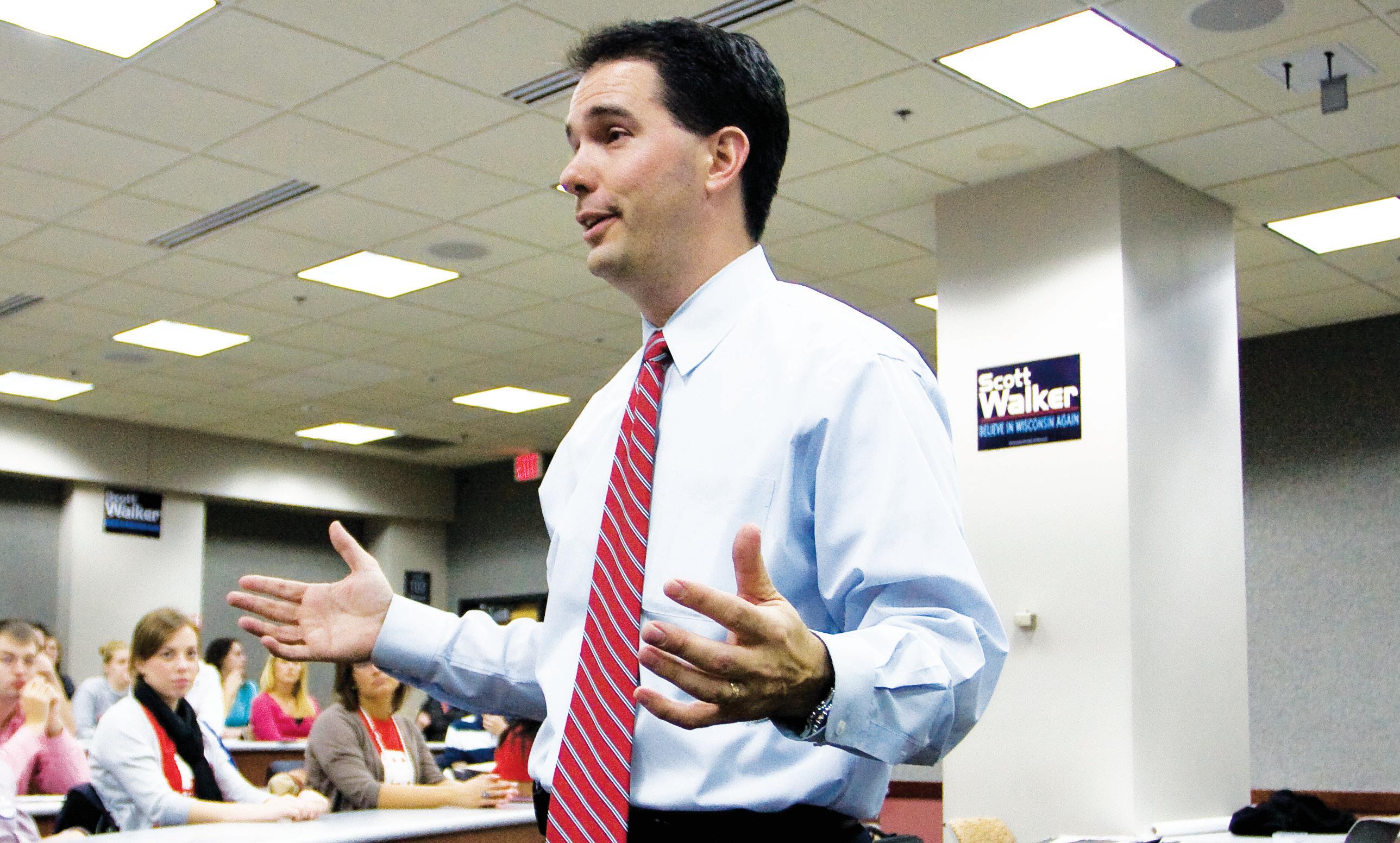
opposing parties and lobbyists, the traditional two or four- year election cycle is a sufficient check on public servants. Elected officials should always be aware of what their constituents want. In a way, the threat of recall elections is one way for politicians to make sure they are in tune with whom they are meant to serve. By no means were the reforms Walker and the Republicans made minor or popular throughout the state. What they did was not found to be illegal or unconstitutional— only very unpopular.
Maybe I don’t sympathize with these recall efforts because growing up in Illinois gave me a different view of what makes a
bad governor. Seeing two former governors, Rod Blagojevich and George Ryan, go to jail for federal corruption charges is good reason to lose faith in an office. Walker’s reforms just don’t seem as bad to me in light of what I’ve seen in my home state. Thanks to a late-night vote last year, this includes a 66 percent income-tax hike.
Should Illinois now recall Gov. Pat Quinn, who signed the unpopular tax-hike? It affects as many people and was done for the same reason as Walker’s reforms. No. What Quinn did is also very unpopular, but he was democratically elected and is allowed to govern as long as he doesn’t break any laws, like Blagojevich did. Quinn will have to answer in the next elec-
tions though, just like Walker should have to answer to his policies in 2014.
Feel free to call me antidemocratic, but I just don’t like recall elections. They cost a lot of money, an estimated $2.14 million, and we have elections to decide whether or not to re-elect governors every four years. Walker’s reforms may be controversial, but they were voted on and passed, appealed and allowed to stand.
So while Democrats and progressives are giddy over the prospect of another election, all I can think is: not one of these again.
Matt Beaty is a junior majoring in mathematics and computer science. Please send all feedback to opinion@dailycardinal.com.

In a relatively quiet vote last week, the Republicancontrolled state Senate passed a bill that would require reforms to sexual education in Wisconsin. If the bill passes, it will recommend teachers teach abstinence as the only certain way to avoid pregnancy. The bill would also require teacher to endorse the values of marriage and parental responsibility. This program, currently used in 26 states, does not require that educators inform students on the health benefits and correct usage of contraceptives. When asked to explain the reasoning for the bill, state Sen. Mary Lazich, R-New Berlin, said, “This is small govern-
ment at its best. This is about local control.”
Of course, the bill is not a declaration of small government as much as a thinly veiled attempt to legislate morality in the public school system. This would be forgivable if there was empirical evidence suggesting abstinenceonly education prevented teenage pregnancy. There is none, and a serious possibility exists that Lazich’s bill will do more harm than good.
were grouped into four categories based on the emphasis the programs placed on abstinence. Averaged together, the study concluded that states with the strongest emphasis on abstinence, including Florida, Louisiana and Mississippi, had higher rates of teen pregnancy and teen birth than those with more comprehensive educational programs.
teen pregnancy.
In a study published three weeks ago by the University of Georgia, the sexual education programs in 48 states
Does this prove that abstinence-only programs cause more teen pregnancies? Not necessarily. The differences between the rates of teen pregnancy are admittedly small, with the difference between the most comprehensive and most abstinence focused groups totaling only 15 pregnancies per 1,000 individuals. Additionally, the survey’s statistics on teen abortions were more erratic, without any clear correlation to be drawn. What they do prove, however, is that a greater focus on abstinence won’t reduce
The goal of any effective sexual education program should be to reduce teen pregnancies and sexually transmitted infections. If those are the goals, then most reliable sources reveal that comprehensive plans are far more effective at preventing unwanted pregnancies. An article in the International Business Times revealed this week that education about contraception and safe sex in a curriculum correlated to a reduced rate of teen pregnancies in Milwaukee by 30 percent over a four-year period.
The reason these comprehensive plans are more effective is that they are more pragmatic; abstinence is the most effective way to avoid getting pregnant, just like not flying is the best way to avoid dying in a plane crash. The comprehensive approach acknowledges that teens will have sex whether or not their teachers tell them they shouldn’t, and
while some pregnancies will happen regardless, a little common sense in this issue goes a long way.
The aforementioned UGA study reveals that other factors, such as the median family income and ethnic background, have much clearer correlative links to teen pregnancies than the education they receive in school. It’s no secret that poorer teenagers are more prone to unplanned pregnancies than those who are well-off. If the state GOP really wanted to fix this problem, it should address the disproportionate distribution of income in the state and the nation as a whole.
But the GOP will never do that. So at the very least, the Republicans could be adults and give kids comprehensive sex education.
Ryan Waal is a freshman majoring in English. Please send all feedback to opinion@dailycardinal.com.




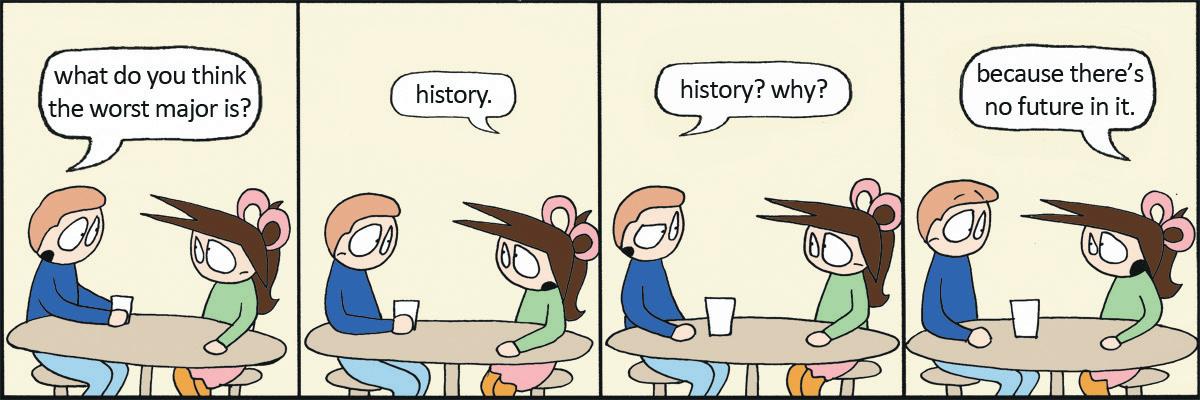
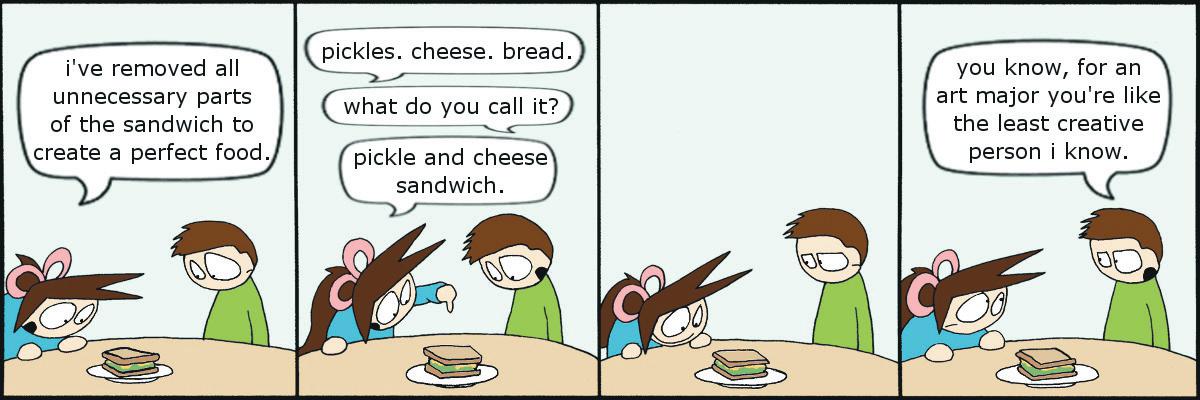


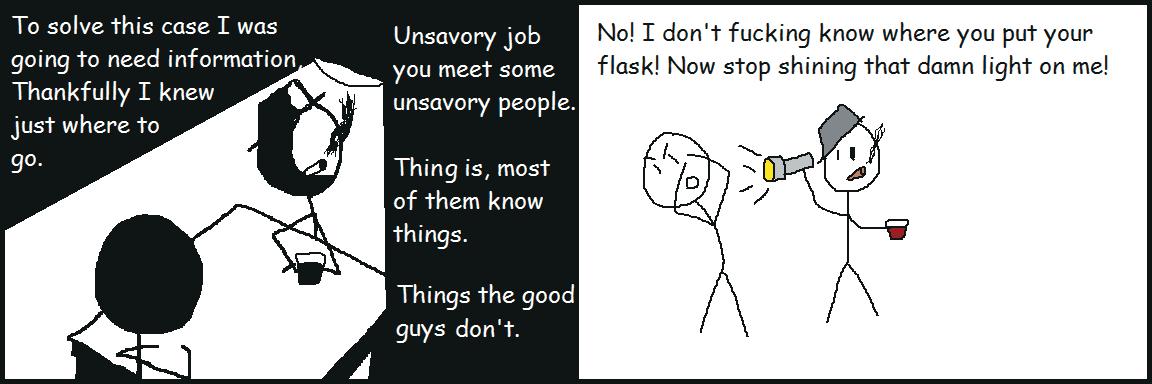


By Ryan Evans
The Daily CarDinal
After salvaging a point on the road this past weekend on the road in St. Cloud, Minn., the ever-growing Wisconsin men’s hockey team (3-4-1 WCHA, 4-5-1 overall) returns home to work out the kinks and prepare for a showdown with No. 1 Minnesota (6-0, 9-1) this weekend at the Kohl Center.
The Gophers were bumped up to the top-spot in the nation this week in both major collegiate hockey polls, adding more fuel to what was already destined to be an intense matchup between two bitter rivals.
“Guys get naturally emotionally jazzed up to play these types of games,” head coach Mike Eaves said. “I think our challenge as a coaching staff is to make sure they don’t get over excited and emotionally jazzed so they can’t play with poise and confidence.”
As for Minnesota’s new No. 1
ranking, Eaves said he isn’t fazed.
“There seems to be a different No. 1 each week, so I don’t think it holds much, at least for us as a coaching staff,” he said.
Eaves said he and his coaching staff are more focused on their team and what they can control rather than on the team they are about to play.
The Badgers’ chief concern is the penalty kill, which has so far been a season-long work in progress, but Eaves said that he is seeing signs of progress.
“We had our first night [this past weekend] where we didn’t give up a goal [on the penalty kill], so that’s a good, healthy sign,” Eaves said. “We’ll continue to work on that and continue to grow. We like the direction we’re going. We’re doing some good things.”
The Wisconsin PK units will have to be better against a Gophers’ power play that has been deadly this season, converting at a 28.3 percent clip, which

ranks first in the WCHA.
The Badgers have had to deal with their fair share of injuries in the early going—losing freshman defenseman Jake McCabe and junior forward Derek Lee for extended periods of time—but Eaves says that he has liked what he has seen from the players who have stepped in for them.
“You have to give [sophomore forward] Keegan Meuer pretty good grades for jumping up into the role he’s been thrust into, and he’s doing a nice job,” Eaves said of Meuer, who has filled Lee’s center spot on the second line. “I think you have to look at [sophomore defenseman] Chase Drake, playing in his first collegiate game after a year of sitting out, and he did a pretty decent job.”
“We looked at it as an opportunity for young men, and they’ve trained hard, and this is an opportunity, and they’ve taken advantage pretty well of it,” Eaves added.
Through all the changes Wisconsin has been forced to undergo early on this season, its

rock through it all has been junior defenseman Justin Schultz. The blueliner leads the team in points with 14 and seems to be playing his best hockey of the year right now.
Eaves has coached plenty of future NHL defensive stars in Madison (Ryan Suter, Ryan McDonagh and Jamie McBain to name a few), and he says there is no question


Schultz’s name belongs right up there with those players.
“He belongs in that class,” Eaves said. “Whenever you have a player that makes people better around him, they’re special players, and that’s what Justin can do as a hockey player. He’ll have his chance one day to see if he can play at that level.”
favor with Ryan for his ability to pick things up on defense, not unlike last year when thenfreshman Josh Gasser was able to pick up playing time because of his ability to pick up the defensive scheme.
“Traevon has developed very quickly and has adopted our reads a lot quicker than some of the other guys, and that’s why he’s got the potential to get more minutes,” Ryan said. “Traevon played because he’s learned a lot of things and he’s using them.”
The Badgers will now prepare for their first regular season game of the year when the take on their first Division 1 opponent in the Kennesaw State Fighting Owls Saturday at the Kohl Center. This game, though not expected to be that close, will be the first real test for Berggren and the rest of the Badgers as they look to remain an elite team this year.

By michael Tews
The Daily CarDinal
While the agony of defeat may be a harsh pill to swallow, the Wisconsin football team (3-2 Big Ten, 7-2 overall) showcased its resiliency with a convincing 62-17 victory over Purdue, avenging two consecutive losses on the road. Wisconsin’s exceptional running attack was in full force as junior running back Montee Ball rushed for a career-high 223 yards and tied Brian Calhoun’s school record of 24 touchdowns in a season.
“He always wants it in his hands, and that’s a great thing to have in terms of a running back that can make big plays when things aren’t necessarily always there,” senior quarterback Russell Wilson said. “He does a great job of pushing himself every day and getting better.”
Ball is poised to have another solid campaign as the Badgers travel to Minnesota to battle a Gopher team (1-4, 2-7) that has struggled mightily against the run. In fact, the Gophers surrender an average of 191.1 yards per game, tied for 92nd in the country and 11th in the Big Ten conference. Also, history appears to favor the Badgers, as a Wisconsin running back has run for at least 100 yards in 10 of the last 11 games against Minnesota.
More importantly, Ball will have an opportunity not only to surpass Calhoun’s record, but to tie or even break the Big Ten record for touchdowns in a season at 26. Only three other backs have reached that mark in the history of the conference: Pete Johnson in 1975 for Ohio State, Anthony Thompson in 1988 for Indiana and Ki-Jana Carter in 1994 for Penn State.
“What Montee has done is in his own hands, we just can give him the support, the program and the developmental phase, but Montee, the way he is wired, has just been spe -
cial,” Wisconsin head coach Bret Bielema said. “I just think Montee is so far advanced beyond Brian [Calhoun], but also other running backs that I’ve been around.”
Wisconsin will need Ball and the running game this weekend because the team is determined to retain control of the coveted Paul Bunyan’s Axe in the Border Battle against rival Minnesota. If the Badgers win, they will have had the axe for eight consecutive seasons.
Wisconsin versus Minnesota is the longest tenured rivalry in college football. This will be the 121st meeting between the teams in a series that dates back to 1890.
In order to motivate his team for this game, Bielema has used some interesting tactics in the past.
“I remember my second or third year, I had a couple of our strength coaches dress up in Gophers uniforms, and at the end of a Thursday practice, they ran on the field, grabbed the axe and ran out, and everybody was looking around like what the hell just happened,” Bielema said. “They had never seen the trophy lost, and I wanted them to feel what that was going to be like.”
Despite a 2-7 overall record, Minnesota has played well in the previous two weeks, knocking off Iowa 22-21 and nearly defeating Michigan State, falling 31-24. The success has come in large part due to the strong play of junior quarterback MarQueis Gray, who threw for 295 yards with three touchdowns and two interceptions in the MSU loss.
“They list him at 240, but he looks bigger than that,” Bielema said. “[Da’Jon] McKnight and him have a really special relationship, especially getting into the end zone, and to me, they are just settling in to what the coaches are telling them.”
The recent success has not

gone unnoticed, and Wilson did not hesitate to give credit to the Gophers.
“We are playing a great team in Minnesota who has been playing great in the last couple games, so we have to be prepared for that,” Wilson said. Yet, even with its strong performances, Wisconsin has been revitalized after returning to its winning ways, and the tradition and importance of the rivalry has added more emotional fuel for players. Wisconsin knows it will have to fight for the Leaders Division crown, and that’s what the Badgers are truly aiming for.
“It means a lot in terms of the pride and tradition here at UW, but it’s just another game on our plate to get prepared for and in our minds; we have to win,” Wilson said. “Every week for us is a championship game, and this is a game we have to win out.”
Following the Wisonsin football team’s 62-17 win over Purdue this past Saturday at Camp randall Stadium, the Big Ten Conference honored Badger junior running back Montee Ball and sophomore linebacker Chris Borland as conference Offensive Player of the Week and Defensive Player of the Week, respectively, for their performances against the Boilermakers.
Ball rushed for a career-high 223 yards on only 20 carries, pushing him over the 1,000-yard mark for the season with 1,076 rushing yards. Ball also scored three touchdowns in the game, giving him 24 on the season, which ties him for the Wisconsin single-season record and puts him only two behind the conference record.

Borland finished the game with 11 tackles, 3.5 of which went for a loss. he also recorded an interception with Purdue backed up deep in its own territory to set up a Wisconsin touchdown. Borland helped the Badgers’ defense hold the Boilermakers to 284 yards of total offense and zero points in the second half of the game.
By ryan evanS /The Daily CarDinal
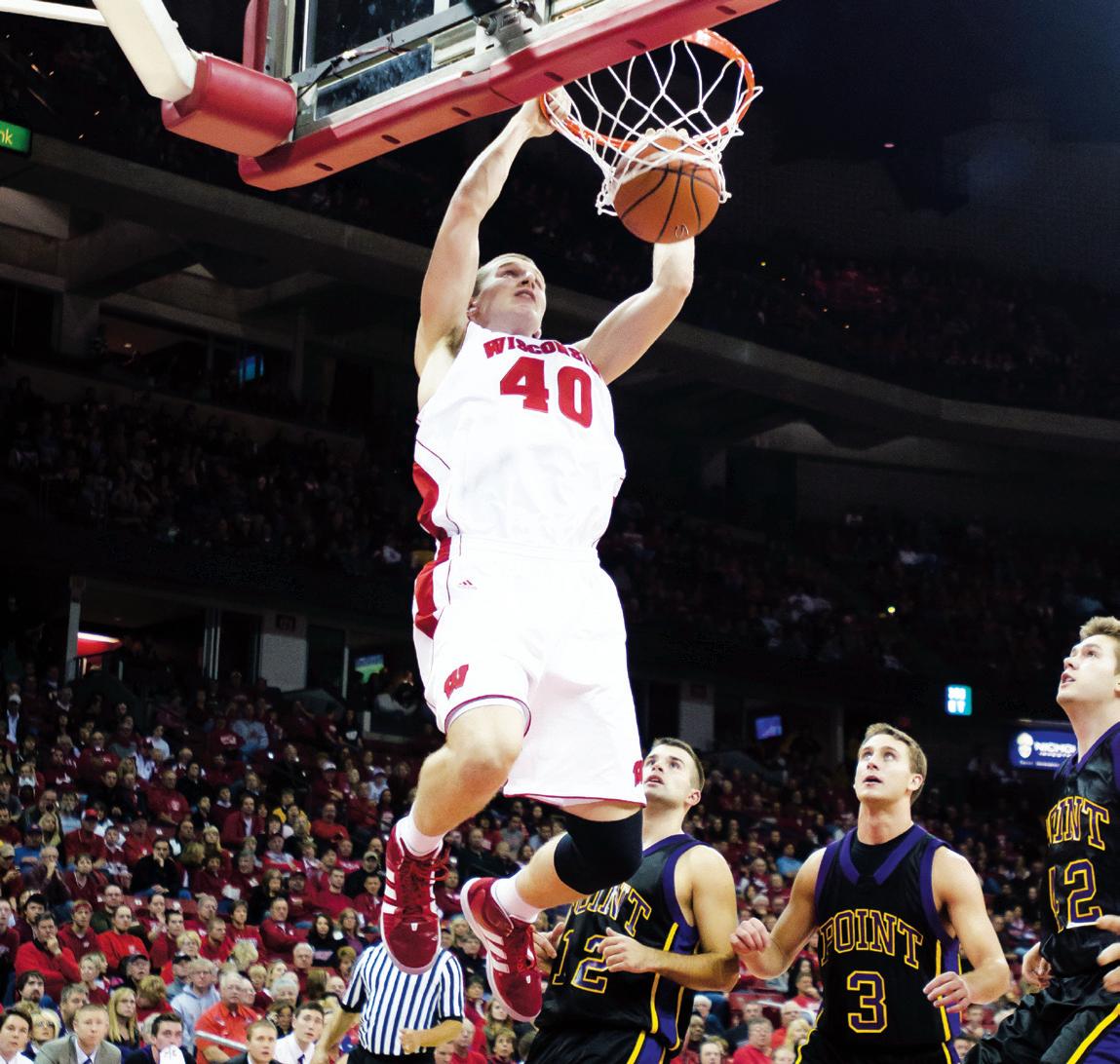
By Ted Porath The Daily CarDinal
The Wisconsin men’s basketball team opened up play Saturday night when it beat UW-Stevens Point in an exhibition game, 80-54.
One of the game’s standouts was redshirt junior Jared Berggren, who scored 12 points and grabbed five rebounds for the Badgers in just 22 minutes of action. Berggren, who will be the starting five-man for Wisconsin this year, must play well if this year’s team hopes to reclaim success. After losing of Jon Leuer, Keaton Nankivil and Tim Jarmusz from last season, the front-line will be mostly new, and head coach Bo Ryan has stressed that replacing them will be vital to success.
“In the front line we’re looking to replace, as I’ve said many times, the defensive read-andreacts that the three guys that
moved on this past year in the front line gave us, and we’ve got a lot of work to do,” Ryan said.
Despits improvements Berggren has made to his strength and agility in the offseason, Ryan believes that he still has a long way to go on reacting on defense and defending the basket.
“The main thing is [Berggren] has to work on helping on the screening situations and stopping smaller guards and forwards from getting to the rim,” Ryan said. “He’s been a little better this year, but we need him to get a lot better before we get into the Big Ten.”
Berggren still has some time to get acclimated to the starting position as the Badgers face relatively soft opponents in their first five games. Wisconsin hopes this period of games can get him ready because if he is not, the Badgers will be in a lot of trouble on Nov. 30 when they
travel to Chapel Hill, N.C. to face the No. 1 Tar Heels and their talented front line.
While the front line’s defense still has some work to do, Ryan has been impressed by the defensive play of senior guard Jordan Taylor, but has also been surprised by the play of freshman guard Traevon Jackson.
“Defensively [Taylor] played really well, and you might say, ‘Yeah but that’s against Stevens Point.’ No. Stevens Point is a very good offensive team,” Ryan said. “Systems [like Stevens Points] are difficult to play against, and I thought Jordan did a very good job of understanding what Giordana wanted to do and the other, Tilema, that he was matched up against.”
Jackson received some substantial playing time Saturday night and has definitely found